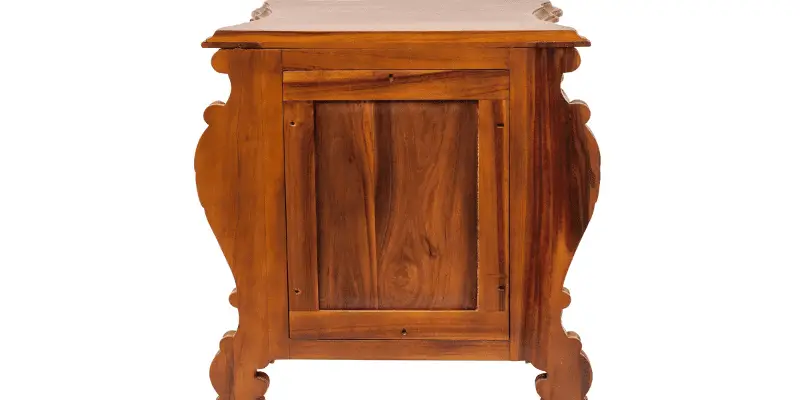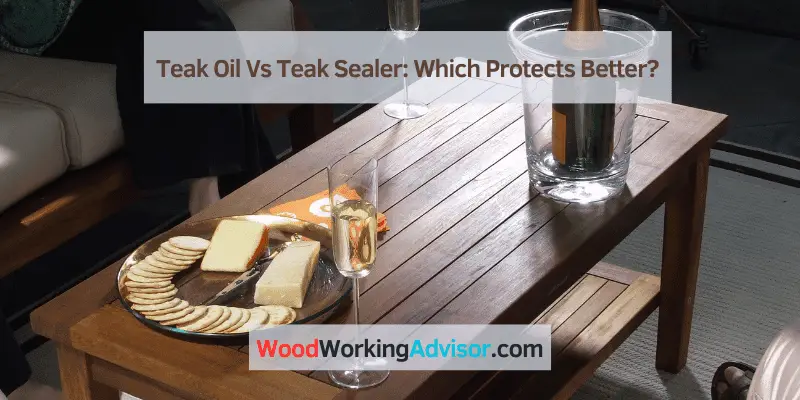Teak oil penetrates the wood to enhance its natural beauty, while teak sealer creates a protective barrier on the wood’s surface. Both products offer different benefits for preserving and maintaining teak furniture and outdoor structures.
Teak oil, often made of linseed or tung oil, nourishes the wood and enhances its color, making it a popular choice for indoor furniture. On the other hand, teak sealers, typically water-based or oil-based, provide a protective layer against UV rays, moisture, and mildew, making them ideal for outdoor teak furniture and structures.
Understanding the differences between teak oil and teak sealer can help you choose the best product for your specific teak maintenance needs. We’ll explore the unique properties and applications of these two popular teak maintenance products to help you make an informed decision.
Understanding Teak Wood
Teak wood is renowned for its exceptional durability and natural resistance to pests and decay, making it a highly sought-after material for outdoor furniture, boat decks, and other applications. However, to maintain its luster and longevity, it requires proper care and protection. In this article, we’ll delve into the properties of teak wood and explore the importance of safeguarding it through the use of teak oil and teak sealer.
Properties Of Teak Wood
Teak wood possesses remarkable natural features that set it apart from other woods. Its high oil content and dense grain contribute to its exceptional resistance to rot, decay, and insect infestation. Additionally, teak is known for its stability, making it an ideal choice for outdoor use. The rich golden-brown color and unique grain patterns of teak wood also make it a popular choice for furniture and outdoor decking.
Importance Of Protecting Teak Wood
Protecting teak wood not only enhances its beauty and longevity but also helps in maintaining its natural properties. Exposure to environmental elements such as sunlight, moisture, and temperature variations can cause teak wood to weather and lose its original luster. Therefore, applying a suitable sealer or oil is crucial to protecting it from damage and maintaining its aesthetic appeal over time.

Teak Oil: Pros And Cons
Teak oil is a popular choice for protecting and enhancing the natural beauty of teak wood. However, like most products, it comes with its own set of advantages and drawbacks. Understanding both the pros and cons of teak oil can help you make an informed decision about whether it is the right choice for your teak furniture or outdoor fixtures.
Benefits Of Teak Oil
Teak oil offers several benefits that make it an attractive option for preserving and maintaining teak wood.
- Enhances natural beauty: Teak oil brings out the rich, warm tones and grain patterns of teak wood, giving it a natural, lustrous finish.
- Protects against moisture: It creates a barrier that helps repel moisture, preventing the wood from warping, cracking, or developing mold or mildew.
- Easy application: Applying teak oil is a straightforward process, making it a convenient choice for DIY enthusiasts.
- Restores faded wood: It can help rejuvenate old or weathered teak, bringing back its original color and shine.
- Repels pests: Teak oil contains natural substances that deter common wood-damaging pests, such as termites and wood-boring beetles.
Drawbacks Of Using Teak Oil
While teak oil offers several advantages, there are also some drawbacks to consider before deciding to use it on your teak wood.
- Requires regular maintenance: Teak oil needs to be reapplied periodically to maintain its protective properties, which adds to the ongoing upkeep of the wood.
- May darken over time: Some teak oils can darken the wood’s natural color with repeated applications, altering its original appearance.
- Short-lived protection: The protective coating provided by teak oil may not be as long-lasting as other sealants, requiring more frequent reapplications.
- Not suitable for all environments: In extremely harsh or wet conditions, teak oil may not provide adequate protection against moisture and weathering.
Teak Sealer: Pros And Cons
Advantages Of Teak Sealer
Teak sealer offers several benefits for maintaining and preserving teak wood furniture and surfaces. Some of the main advantages of using teak sealer include:
- Protection: Teak sealer forms a protective barrier on the surface of the wood, guarding it against moisture, UV rays, and other environmental damage.
- Enhanced Durability: By sealing the pores of the wood, teak sealer helps to enhance the durability and lifespan of teak furniture, making it more resistant to wear and tear.
- Color Retention: Teak sealer can help retain the natural golden color of teak wood, preventing it from turning gray and weathered over time.
- Low Maintenance: Applying teak sealer can reduce the frequency of maintenance and refinishing, simplifying the care routine for teak furniture.
Disadvantages Of Using Teak Sealer
While teak sealer offers various benefits, there are also some potential drawbacks associated with its use, including:
- Loss of Natural Beauty: Some individuals prefer the aged, silver-gray patina that teak develops over time without the use of a sealer. Using a sealer can prevent the natural aging process of teak wood.
- Application Process: Proper application of teak sealer requires careful preparation and consistent maintenance, which may pose a challenge for some users.
- Cost: High-quality teak sealers can be relatively expensive, especially when considering the ongoing maintenance and reapplication that may be necessary.
- Risk of Trapping Moisture: If not applied correctly, teak sealer can potentially trap moisture within the wood, leading to issues such as mold or mildew growth.
Application And Maintenance
When it comes to preserving the beauty and integrity of teak outdoor furniture, choosing between teak oil and teak sealer can be a pivotal decision. Both options offer unique benefits and require different application and maintenance techniques. Understanding how to apply teak oil and teak sealer, as well as their respective maintenance requirements, is essential to ensure the longevity and aesthetics of your outdoor teak furniture.
How To Apply Teak Oil
- Clean the teak furniture with a mild soap and water solution and allow it to dry completely.
- Apply teak oil using a brush or lint-free cloth, following the wood’s grain. Ensure an even and generous application to penetrate the wood pores.
- Allow the first coat to soak for about 15-30 minutes. Then, wipe off any excess oil with a clean cloth.
- Apply additional coats, if necessary, allowing each coat to dry and wiping off excess oil before the next application.
- Maintain the teak furniture by applying a fresh coat of teak oil every 3-6 months or as needed, depending on weather exposure.
How To Apply Teak Sealer
- Clean the teak furniture thoroughly and let it dry completely before applying the teak sealer.
- Using a brush or cloth, evenly coat the surface with teak sealer, ensuring complete coverage and saturation.
- Allow the first coat to dry per the product’s instructions and apply additional coats as recommended by the manufacturer.
- Maintain the teak furniture by reapplying teak sealer as per the product’s guidelines, typically every 1-2 years.
Maintenance Requirements For Both
After applying teak oil or sealer, regular maintenance is essential to prolong the life of the teak furniture and retain its beauty. Here are the maintenance requirements for both:
| Teak Oil | Teak Sealer |
|---|---|
| Requires reapplication every 3-6 months or as needed | Need to be reapplied every 1-2 years for optimal protection |
| Protects against moisture and maintains the natural golden color of teak | Provides long-term protection against weather, UV rays, and moisture |
| May require light sanding before reapplication to remove the old layer | May need a light cleaning with a mild detergent before reapplication |
Comparing Protection Efficacy
When it comes to protecting your teak furniture, it’s important to understand the differences between teak oil and teak sealer. Among the key factors to consider is the protection efficacy offered by each type of product. Let’s delve into comparing the long-term effects of teak oil and teak sealer to help you make an informed decision for preserving your valuable teak furniture.
Long-term Effects Of Teak Oil
Teak oil is renowned for enhancing the natural beauty of teak wood while providing a protective barrier against moisture, UV rays, and other environmental elements. Its penetrating properties deeply nourish the wood, preventing it from drying out and potentially cracking. However, in the long term, teak oil may require reapplication every few months to maintain its protective qualities. Over time, teak oil may gradually wear off due to exposure to weather conditions and regular use, potentially leaving the wood vulnerable.
Long-term Effects Of Teak Sealer
On the other hand, teak sealers are designed to form a durable layer of protection on the surface of the wood, creating a shield against moisture, UV damage, and other external factors. Unlike teak oil, a quality teak sealer is formulated to provide long-lasting protection, with some products boasting a lifespan of up to three years before reapplication is necessary. With proper application and maintenance, teak sealers can effectively safeguard the wood and minimize the need for frequent reapplications.
Frequently Asked Questions Of Teak Oil Vs Teak Sealer
What Is The Difference Between Teak Oil And Teak Sealer?
Teak oil penetrates the wood to nourish and protect, while teak sealer forms a protective barrier on the surface. Teak oil brings out the natural grain and color, while sealer provides UV protection and water resistance.
Can Teak Oil Be Used Over Teak Sealer?
Applying teak oil over a teak sealer is not recommended as it may not bond properly with the sealed surface. For maintenance, sand the wood lightly to remove the sealer, then apply the teak oil as needed.
How Often Should Teak Furniture Be Treated With Sealer Or Oil?
The frequency of reapplication depends on the exposure to elements and the look you want to maintain. Generally, teak furniture should be treated with sealer or oil every 6 to 12 months for optimal protection and appearance.
Are There Any Precautions Or Tips For Applying Teak Oil Or Sealer?
Before applying teak oil or sealer, ensure the surface is clean and dry. Apply in thin, even coats using a brush or cloth, and allow proper drying time between coats. Dispose of oil-soaked rags properly to prevent combustion.
Conclusion
In the end, choosing between teak oil and teak sealer depends on your specific needs. Both options offer benefits for protecting and enhancing your teak furniture, so it’s important to consider your priorities and desired outcome. Whether you prioritize natural color preservation or longer-lasting protection, it’s essential to make an informed decision based on your unique requirements.


